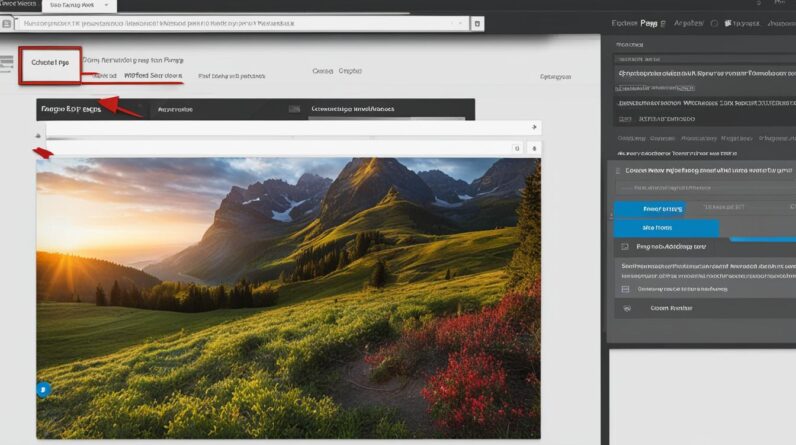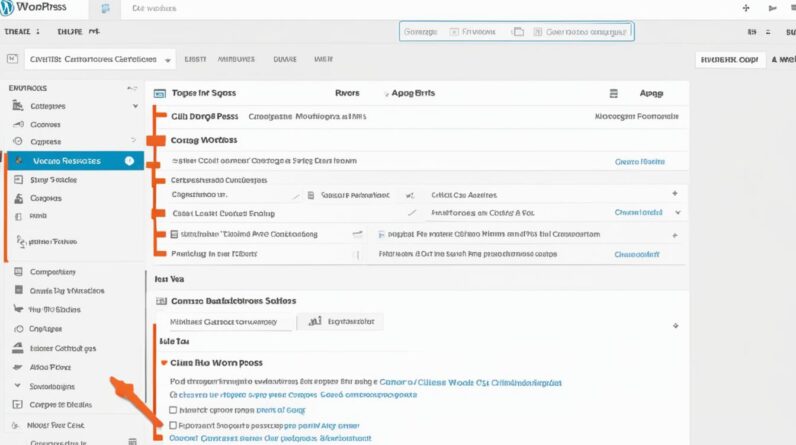Hello there, fellow WordPress users! Are you struggling to find the page ID of a specific page in your WordPress CMS? Well, you’re in luck! In this quick guide, I’m going to walk you through some simple methods to effortlessly retrieve the page ID in your WordPress website. Whether you’re a beginner or an experienced user, these step-by-step instructions will help you locate the page ID in no time!
How to Make Money with YouTube
Create an empire of automated video websites for multiple streams of income
Key Takeaways:
- Knowing how to find the page ID or post ID is essential for customizing and optimizing your WordPress website.
- You can manually find the page ID or post ID by accessing the “Pages” or “Posts” section in your WordPress dashboard and locating the specific page or post.
- Installing plugins like “Reveal ID” or “Show ID” can simplify the process by displaying the IDs directly in your WordPress dashboard.
- If you need to find IDs in bulk, using plugins can streamline the process and make it more efficient.
- If you prefer not to use a plugin, you can retrieve page and post IDs directly from the WordPress database using tools like phpMyAdmin.
Understanding Page and Post IDs in WordPress
Every piece of content on a WordPress site, such as pages and posts, has a unique ID number called a Page/Post ID. These IDs are essential for themes, plugins, and widgets to identify and locate specific parts of the site. The IDs are also necessary for certain code to work and allow for advanced tasks and targeting specific areas of the website. For example, IDs can be used to display widgets only on certain posts or target specific media, categories, or tags. Knowing how to find these IDs can simplify customizations and optimize website functionality.
WordPress assigns a unique ID to every page and post in its content management system (CMS). These IDs serve as identifiers for WordPress to distinguish and manage different elements of the website efficiently.
Page and post IDs play a crucial role in various aspects of WordPress development, customization, and functionality. They enable developers to target specific content, implement advanced features, and customize various elements based on the unique IDs assigned to each page or post.
Understanding page and post IDs empowers website owners, developers, and administrators to streamline their workflows, optimize their website’s functionality, and enhance the overall user experience.
Finding Page and Post IDs Manually
In WordPress, locating the page ID or post ID can be done manually by following a few simple steps. Here’s how you can find the IDs for pages and posts:
- Login to your WordPress dashboard.
- Go to the “Pages” or “Posts” section, depending on the type of ID you need.
- Find the specific page or post you want to retrieve the ID for and click on its “Edit” button.
- In your browser’s address bar, look for the ID number after the text “?post=”. This number represents the page ID or post ID you are looking for.
This method can also be used to find IDs for other elements in WordPress, such as categories, tags, and media. Keep in mind that the URL structure may vary depending on the permalink settings.
URL Structure for Page ID
The URL structure for a page ID in WordPress typically follows this format:
example.com/?post=123
Replace “123” with the actual page ID you retrieved using the method mentioned above.
URL Structure for Post ID
The URL structure for a post ID in WordPress usually follows this pattern:
example.com/?post=456
Replace “456” with the actual post ID you retrieved using the method mentioned earlier.
The process of manually finding page and post IDs in WordPress allows you to quickly identify and locate the specific content you need. Whether you are customizing your website or working with plugins and themes, knowing these IDs can significantly streamline your workflow and enhance your overall WordPress experience.
Displaying Page and Post IDs in WordPress Dashboard
If you prefer to have the page IDs and post IDs displayed directly in your WordPress dashboard, there are a few options available.
One method is to add a custom code snippet to the theme’s “functions.php” file to create an additional column that shows the IDs in the posts or pages menu. This way, you can easily reference and work with the IDs without leaving the dashboard.
This is particularly useful for developers or website administrators who frequently need to access and identify specific pieces of content.
If you’re not comfortable editing the theme’s code, don’t worry. WordPress offers plugins that can help you display IDs in the dashboard without any coding required. Two popular options are the “Reveal ID” and “Show ID” plugins.
Reveal ID plugin:
- Adds an ID column to posts, pages, tags, categories, and more.
- Provides a straightforward interface for enabling and disabling the display of IDs in each content menu.
- Easily view and manage IDs within the WordPress dashboard with the Reveal ID plugin. (Image:
Show ID plugin:
- Enhances the dashboard by adding an ID column to various content menus.
- Allows you to configure the plugin to display IDs in different areas of the dashboard.
- Conveniently access and work with IDs directly from within your WordPress dashboard using the Show ID plugin.
By utilizing these plugins, you can streamline your workflow and make it more efficient to view and manage IDs while working on your WordPress website.
No matter which option you choose, displaying page and post IDs in the WordPress dashboard gives you quick and easy access to essential information, allowing for smoother content management and customization.
| Method | Description | Benefits |
|---|---|---|
| Add custom code snippet to functions.php | Create additional ID column in posts or pages menu | – Easy access to IDs within the dashboard – No need for plugins |
| Reveal ID Plugin | Adds ID column to posts, pages, categories, and more | – Simple interface for enabling or disabling ID display – Convenient management of IDs in the dashboard |
| Show ID Plugin | Enhances dashboard with ID column in various menus | – Configurable display settings – Streamlined access to IDs within dashboard |
Bulk Retrieval of Page and Post IDs with Plugins
If you have a large number of pages and posts on your WordPress website and need to find IDs in bulk, using a plugin can significantly streamline the process. Two popular plugins that can help you with this task are the “Reveal ID” and “Show ID” plugins.
These plugins offer the functionality to display page and post IDs in a separate column within your WordPress dashboard. By configuring the plugins to show IDs, you can easily identify and manage IDs for multiple content items simultaneously. You can find IDs for posts, pages, categories, tags, and media, all in one convenient location.
Once you have installed and activated the plugin of your choice, it will automatically add a new column in the appropriate sections of your WordPress admin panel where you view your content. This new column will display the IDs alongside the titles of your pages and posts, making it quick and easy to locate the required IDs.
Configuring these plugins for bulk ID retrieval is a straightforward process. After installation and activation, you can navigate to the specific content section in your WordPress dashboard. For example, if you want to find the page IDs for all your pages, go to the “Pages” section.
Below is an example of how the ID column will be displayed:
| Title | ID |
|---|---|
| Page Title 1 | 123 |
| Page Title 2 | 456 |
| Page Title 3 | 789 |
Using these plugins not only simplifies the process of finding IDs in bulk but also streamlines the editing of widgets and plugins that require specific IDs. Instead of manually searching for each ID individually, you can have all the necessary information readily available at a glance.
These plugins are lightweight and designed to minimize any impact on your website’s performance. You can enjoy the benefits of bulk ID retrieval without sacrificing the speed and efficiency of your site. Whether you have a small business website or a large-scale WordPress platform, these plugins are ideal for managing IDs efficiently.
Next time you need to find IDs in bulk, consider leveraging the power of plugins like “Reveal ID” or “Show ID” to simplify the process and make your workflow more efficient.
Retrieving Page and Post IDs from the WordPress Database
If you prefer not to use a plugin and have access to your WordPress database, you can retrieve page and post IDs directly from the database. By using tools like phpMyAdmin, which is often accessible through cPanel, you can navigate to the wp_posts table within the appropriate database. In this table, you can find a column that displays each post’s ID along with other relevant information. This method allows you to find IDs without relying on additional plugins and gives you direct access to the underlying data.
Step-by-Step Guide: Retrieving IDs from the WordPress Database
- Access your cPanel or hosting control panel.
- Locate and open phpMyAdmin.
- Select the appropriate WordPress database.
- Find and select the wp_posts table.
- Look for the column labeled “ID”.
- Retrieve the IDs for the desired pages or posts.
By following these steps, you can retrieve the page and post IDs directly from the WordPress database. This method gives you direct access to the information you need without relying on third-party plugins. It’s particularly useful if you prefer a more hands-on approach or if you’re working on a website where additional plugins may not be necessary.
| Advantages of Retrieving IDs from the WordPress Database |
|---|
| 1. No reliance on additional plugins |
| 2. Direct access to underlying data |
| 3. Increased control over website customization |
| 4. Better understanding of the WordPress database structure |
Retrieving page and post IDs from the WordPress database using phpMyAdmin and cPanel gives you the flexibility to work directly with the data. Whether you need the IDs for customization purposes or simply want a deeper understanding of your WordPress website’s structure, this method provides a straightforward and efficient solution.

Displaying Page and Post IDs on the Front-End Using PHP
If you want to display the page or post IDs on the front-end of your WordPress website, you can use the built-in the_ID() function in PHP. This function allows you to customize and interact with specific parts of your website based on the IDs of the pages or posts.
The the_ID() function needs to be used within a loop to work properly. By incorporating this function into your code, you can access and display the IDs of the individual pages or posts within the loop. This opens up a range of possibilities for adding custom functionality to your WordPress website based on these unique IDs.
To demonstrate how the the_ID() function can be used in a loop, consider the following example:
<?php
if ( have_posts() ) {
while ( have_posts() ) {
the_post();
?>
<h3>ID: <?php the_ID(); ?></h3>
<h2><?php the_title(); ?></h2>
<p><?php the_content(); ?></p>
<?php
}
}
?>In this example, the the_ID() function is used to display the ID of each page or post along with its title and content. By incorporating the function within the loop, it retrieves the ID of each individual page or post.
Using the the_ID() function within a loop provides you with the ability to add custom functionality to your WordPress website based on specific page or post IDs. Whether it’s displaying additional information, applying conditional styling, or targeting specific content, leveraging the power of IDs can enhance the customization and interactivity of your front-end.
| Benefits of Displaying Page and Post IDs on the Front-End |
|---|
| 1. Enhanced customization and interactivity |
| 2. Targeting specific content based on IDs |
| 3. Application of conditional styling |
| 4. Improved user experience with tailored content |
Benefits and Applications of Knowing Page and Post IDs
Understanding the page IDs and post IDs in WordPress can offer a multitude of benefits and unlock numerous application possibilities for your website. By familiarizing yourself with these IDs, you can enhance your website’s customization and optimization capabilities, providing a better experience for both you and your visitors.
Customizations Based on IDs
Knowing the page IDs and post IDs enables you to make customizations tailored to specific content elements. For instance, you can enable or disable certain features within plugins based on these IDs, allowing you to control the functionality of your website with precision and efficiency.
Targeting Specific Content with IDs
The knowledge of page IDs and post IDs empowers you to target specific content on your website. By using these IDs, you can display different widgets on specific posts or pages, ensuring that your content is effectively showcased to your audience. Additionally, you can direct your attention to specific media, categories, or tags based on their respective IDs, achieving a highly targeted and organized website structure.
Optimizing Website Functionality
Page IDs and post IDs play a vital role in optimizing your website’s functionality. These unique identifiers allow you to implement advanced customizations, such as adding custom functionality to your WordPress website based on the IDs of pages or posts. With this level of control, you can tailor your website to meet your specific requirements, resulting in an enhanced user experience and increased engagement.
| Benefits of Knowing Page and Post IDs | Applications of Page and Post IDs in WordPress |
|---|---|
|
|
By harnessing the power of page and post IDs, you can unlock the full potential of your WordPress website. Streamline your customization process, target specific content effortlessly, and optimize your website’s functionality to create a seamless and engaging user experience. Incorporate the knowledge of page and post IDs into your WordPress workflow and elevate your website to new heights of performance and creativity.
Conclusion
In conclusion, understanding and utilizing page and post IDs in WordPress can greatly optimize your workflow and enhance your website’s functionality. By following the methods outlined in this guide, you can easily find and use page IDs and post IDs in your WordPress website.
Whether you prefer to manually locate IDs, display them in the dashboard, use plugins, access the database, or utilize PHP functions, the knowledge of these IDs allows you to customize your website effortlessly. Knowing the unique IDs of your pages and posts enables you to target specific content, enable or disable features, and display different widgets based on the IDs.
By customizing your website’s functionality based on these IDs, you can have greater control over your WordPress website. This optimization not only saves time but also enhances your workflow by streamlining the editing process. Take full advantage of the benefits and applications of knowing page and post IDs to ultimately create a more efficient and personalized website.
FAQ
How can I find the page ID or post ID in WordPress?
To find the page ID or post ID in WordPress, log in to your WordPress dashboard and navigate to the “Pages” or “Posts” section. Click on the “Edit” button for the specific page or post you want to find the ID for. In the URL displayed in your browser’s address bar, locate the number after “?post=”. This number is the page ID or post ID.
Can I display page and post IDs directly in my WordPress dashboard?
Yes, you can display page and post IDs directly in your WordPress dashboard. There are a few methods to do this. One option is to add a custom code snippet to your theme’s “functions.php” file, which adds an additional column displaying the IDs in the posts or pages menu. Another option is to install a plugin like “Reveal ID” or “Show ID,” which automatically adds an ID column to various content menus in your dashboard.
Is there a way to find page and post IDs in bulk?
Yes, you can find page and post IDs in bulk by using plugins like “Reveal ID” or “Show ID.” These plugins display IDs in a separate column for posts, pages, categories, tags, and media, allowing you to easily manage and customize multiple IDs at once.
Can I retrieve page and post IDs directly from the WordPress database?
Yes, if you have access to your WordPress database, you can retrieve page and post IDs directly from it. Tools like phpMyAdmin, often accessible through cPanel, allow you to navigate to the wp_posts table where you can find the column displaying the IDs along with other relevant information.
How can I display page and post IDs on the front-end of my WordPress website?
To display page and post IDs on the front-end of your WordPress website, you can use the built-in function called the_ID(). This function needs to be used within a loop. By incorporating this function into your code, you can customize and interact with specific parts of your website based on their IDs.
What are the benefits of knowing page and post IDs in WordPress?
Knowing page and post IDs in WordPress comes with several benefits. It allows you to customize your website more efficiently by enabling or disabling features within plugins, displaying different widgets on specific posts or pages, and targeting media, categories, or tags based on their IDs. Understanding and leveraging IDs gives you greater control over your website’s functionality and enables advanced customization.






